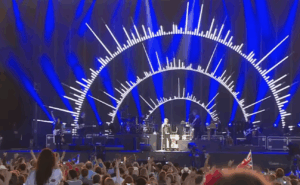4 Most Boring Rockumentaries About Classic Rock

via Led Zeppelin / YouTube
When rock bands tell their stories, fans expect behind-the-scenes access to their favorite musicians and unfiltered truths. However, not all rockumentaries hit the right note. Some fail to deliver the excitement and insight we crave, feeling as dull as a dimly lit backstage area. Let’s explore a few rock documentaries that received less-than-stellar receptions despite featuring some of the most beloved bands in classic rock.
1. “Led Zeppelin: The Song Remains the Same”
Capturing the legendary Led Zeppelin at the peak of their fame in the mid-70s, “The Song Remains the Same” should have been a thrilling watch. Instead, it’s often remembered for lengthy, surreal fantasy sequences that leave viewers scratching their heads. The band’s performances were intercut with these imagined scenes, which many fans felt broke the rhythm of the concert experience. While the music itself was impactful, the concert footage was hampered by these strange additions, making it less of a definitive rockumentary and more of a curiosity.
Adding to the disappointment, the film’s pacing felt off, with too much focus on off-stage antics and not enough on the live performance that should’ve been the film’s heart. Fans came expecting to see their idols in all their glory but ended up getting a confusing mix of fantasy and reality that failed to resonate. Even the band members expressed dissatisfaction with the final product, making this rockumentary a sleepy footnote in an otherwise explosive career.
2. “Gimme Shelter”
The Rolling Stones’ “Gimme Shelter” sets out to document the group’s 1969 U.S. tour, which culminated in the infamous Altamont free concert. Despite the potential for a gripping story, the documentary falls short of its promise. It lacks a clear narrative flow, causing some viewers to find it disjointed and emotionally flat. The film’s dark undercurrent, underscored by the tragic events at Altamont, casts a pall over the entire documentary, leaving a sense of gloom instead of the expected rock ‘n roll thrill.
Moreover, the documentary’s focus on the chaos surrounding The Rolling Stones, rather than the band’s music, makes it feel like more of a cautionary tale than a celebration of rock. It’s a rockumentary that should be brimming with energy, but it misses the mark, becoming a somber watch that might leave audiences more exhausted than entertained.
3. “Bob Dylan: Eat The Document”
Bob Dylan is an enigmatic figure in music, but “Eat The Document” does little to demystify the artist for fans. Intended as an experimental tour film, it manages to capture Dylan during an important phase of his career but is often criticized for its incoherent structure. The raw footage felt unfocused, and without a clear purpose, it’s more of a puzzle than a portrait of the singer-songwriter.
The absence of context or a strong storyline in “Eat The Document” makes it hard for viewers to connect with the footage. Dylan fans might seek a deeper understanding of his thoughts and motivations during his 1966 tour, but this rockumentary leaves those stones unturned, resulting in a viewing experience that’s more lackluster than enlightening.
4. “The Beatles: Let It Be”
Even The Beatles, perhaps the most famous band in history, are not immune to a dull rockumentary. “Let It Be” was meant to showcase the band’s recording process for their final album, offering insights into their dynamic. However, rather than capturing the ingenuity of The Beatles, the film is often remembered for its dreary portrayal of the group’s internal strife and discord. Such revelations can be riveting, but the execution here felt uninspired and left fans disenchanted.
The documentary’s atmosphere is heavy with tension, and the lack of joyful moments makes for a somber account. It’s a piece of cinema that, while historically significant, struggles to maintain the interest of even hardcore Beatles enthusiasts. “Let It Be” was intended to put viewers in the room with the band, but instead of feeling like a fly on the wall, audiences might feel like they’re seated too far from the action.

















